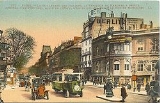
Palais Berlitz
Encyclopedia
The Palais Berlitz is an office building built in Paris in the 1930s on a quadrilateral formed by the Boulevard des Italiens
, the rue Louis-le-Grand, the Rue de la Michodière and the rue du Hanovre.
It was built in place of the Pavillon du Hanovre which was dismantled and rebuilt in a park in the suburb of Paris.
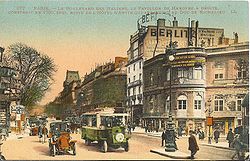
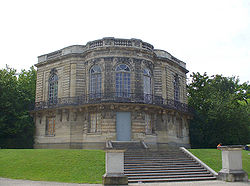 Le Pavillon de Hanovre was built between 1758 and 1760 by the French architect Jean-Michel Chevotet
Le Pavillon de Hanovre was built between 1758 and 1760 by the French architect Jean-Michel Chevotet
(1698-1772) in the gardens of Maréchal de Richelieu
rue Neuve-Saint-Augustin (currently Boulevard des Italiens
).
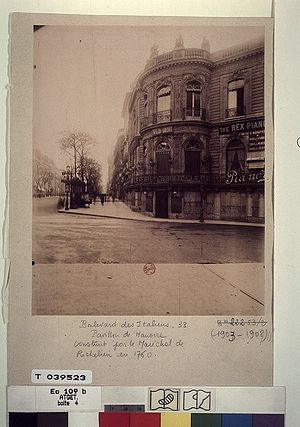 During the construction of the Palais Berlitz, it was disassembled and rebuilt in 1932 in Parc de Sceaux. The work was performed under the direction of the architect Léon Azéma, assisted by Louis Plousey and Urbain Cassan.
During the construction of the Palais Berlitz, it was disassembled and rebuilt in 1932 in Parc de Sceaux. The work was performed under the direction of the architect Léon Azéma, assisted by Louis Plousey and Urbain Cassan.

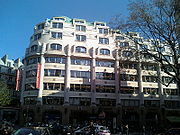 Under the name of the Palace of Hanover, it was built as an office building in the 1930s by the French architect Charles Lemaresquier (1870-1972) who conceived other buildings in the same style such as the headquarters of Félix Potin.
Under the name of the Palace of Hanover, it was built as an office building in the 1930s by the French architect Charles Lemaresquier (1870-1972) who conceived other buildings in the same style such as the headquarters of Félix Potin.
At the ground floor were stores and a newsreel theatre that seated 200.
The building was renamed the Palais Berlitz after the English language school which located to the building. In the 1950s the ground floor and basement of the building were converted into a 1,500-seat cinema called the Berlitz, and the old newsreel theatre was turned into a restaurant.
It was one of the most important first run movie theatres in Paris at that time. The design featured a huge curved lobby with stained glass windows leading to the big auditorium which had club armchairs. However, due to two large columns in the auditorium space, the size of the screen was limited.
In the 1980s Gaumont took over and divided the Berlitz including the restaurant (the former newsreel house) into six small screens. The place lost its original design and was not attractive.
In the 1990s the building was entirely rebuilt with only the facade remaining. In the new building, the new six-screen multiplex run by Gaumont has a much nicer design and has a total seating capacity of 1,137.
After the fire of the Credit Lyonnais headquarters
, the French bank LCL
installed there its main branch.
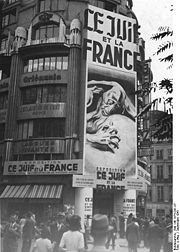 Palais Berlitz is especially sadly notorious for an antisemitic exhibition during Nazi occupation Le juif et la France (5 September 1941-15 January 1942).
Palais Berlitz is especially sadly notorious for an antisemitic exhibition during Nazi occupation Le juif et la France (5 September 1941-15 January 1942).
Boulevard des Italiens
The boulevard des Italiens is one of the four 'grands boulevards' in Paris, a chain running east west and also including boulevard de la Madeleine, Boulevard des Capucines and boulevard Montmartre...
, the rue Louis-le-Grand, the Rue de la Michodière and the rue du Hanovre.
It was built in place of the Pavillon du Hanovre which was dismantled and rebuilt in a park in the suburb of Paris.
Le Pavillon de Hanovre


Jean-Michel Chevotet
Jean-Michel Chevotet was a French architect. He and Pierre Contant d'Ivry were among the most eminent Parisian architects of the day and designed in both the restrained French Rococo manner, known as the "Louis XV style" and in the "Goût grec" phase of early Neoclassicism...
(1698-1772) in the gardens of Maréchal de Richelieu
Louis François Armand du Plessis, duc de Richelieu
Armand de Vignerot du Plessis was a French soldier, diplomat and statesman. Joining the army, he participated in three major wars and eventually rose to the rank of Marshal of France....
rue Neuve-Saint-Augustin (currently Boulevard des Italiens
Boulevard des Italiens
The boulevard des Italiens is one of the four 'grands boulevards' in Paris, a chain running east west and also including boulevard de la Madeleine, Boulevard des Capucines and boulevard Montmartre...
).

Le palais Berlitz


At the ground floor were stores and a newsreel theatre that seated 200.
The building was renamed the Palais Berlitz after the English language school which located to the building. In the 1950s the ground floor and basement of the building were converted into a 1,500-seat cinema called the Berlitz, and the old newsreel theatre was turned into a restaurant.
It was one of the most important first run movie theatres in Paris at that time. The design featured a huge curved lobby with stained glass windows leading to the big auditorium which had club armchairs. However, due to two large columns in the auditorium space, the size of the screen was limited.
In the 1980s Gaumont took over and divided the Berlitz including the restaurant (the former newsreel house) into six small screens. The place lost its original design and was not attractive.
In the 1990s the building was entirely rebuilt with only the facade remaining. In the new building, the new six-screen multiplex run by Gaumont has a much nicer design and has a total seating capacity of 1,137.
After the fire of the Credit Lyonnais headquarters
Crédit Lyonnais headquarters
The Crédit Lyonnais headquarters is installed in a haussmannian style building in the 2nd arrondissement of Paris...
, the French bank LCL
LCL
LCL can mean:* Labor Contract Law, a 2008 Chinese law intended to protect workers* Lateral collateral ligament, a ligament found on the outside apect of the knee* Lazarus Component Library, the Lazarus GUI subsystem, similar to Borland VCL...
installed there its main branch.
Exhibition Le juif et la France (=The jew and the France)


